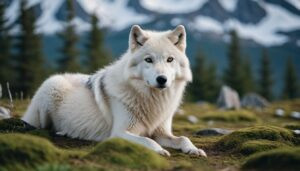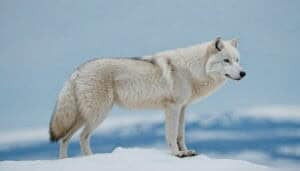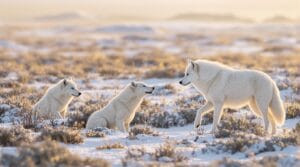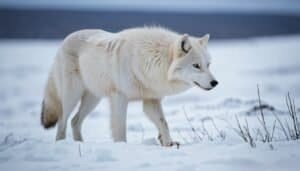Introduction
The survival of Arctic wolves is intricately linked to the availability of their prey. In this article, we will explore the main prey species and hunting strategies of Arctic wolves, the factors leading to the decline of these prey species, and the subsequent effects on wolf survival
We will also examine the adaptations Arctic wolves have developed to cope with prey scarcity, their role in the ecosystem, and the ongoing conservation efforts to protect both the wolves and their prey
The Main Prey Species and Hunting Strategies of Arctic Wolves
The survival of Arctic wolves heavily depends on their ability to hunt and capture prey. In the harsh Arctic environment, these wolves have adapted to pursue various prey species and employ specific hunting strategies to ensure their survival
Typical Prey Animals
Arctic wolves primarily feed on a range of animals that are abundant in their habitat. The most common prey includes:
Caribou: A significant part of the Arctic wolf’s diet, caribou are large herbivores that travel in herds. Wolves often follow these herds and target weaker or young individuals
Muskoxen: Another primary prey, muskoxen are large and formidable, requiring coordinated pack efforts to hunt successfully
Arctic Hares: Smaller and more abundant, Arctic hares are often hunted by solitary wolves or smaller packs, providing a more consistent food source
Lemmings and Rodents: In times of prey scarcity, Arctic wolves may hunt smaller mammals like lemmings and other rodents to sustain themselves
Seasonal Variations in Diet
The Arctic environment experiences extreme seasonal changes, which significantly affect the availability of prey. During the summer, prey species like caribou and hares are more accessible as they migrate and forage
Wolves take advantage of this abundance to build up their strength and store energy for the harsher winter months
In contrast, winter presents a more challenging hunting environment. Snow and ice cover the landscape, making it difficult for wolves to track and capture prey. During this period, wolves may rely more on stored fat reserves and may have to travel greater distances to find food
The scarcity of prey in winter often leads to increased competition among wolf packs and other predators
Pack Hunting Tactics
Arctic wolves are known for their exceptional pack hunting skills, which are crucial for taking down larger prey like caribou and muskoxen. These tactics involve:
Cooperative Strategies: Wolves use sophisticated communication and coordination to encircle and isolate a target. They often work together to distract and tire out their prey before launching a final attack
Role Specialization: Within a pack, different wolves may take on specific roles during a hunt, such as leading the chase, flanking the prey, or waiting in ambush
Endurance Hunting: Wolves are capable of traveling long distances and maintaining high speeds to pursue prey over extended periods. This endurance allows them to outlast and eventually capture their targets
Solitary Hunting
While pack hunting is more efficient for larger prey, Arctic wolves also exhibit solitary hunting behavior, especially when targeting smaller animals like hares and rodents. Solitary hunting requires:
Stealth and Patience: A lone wolf must rely on stealth and patience to approach and capture smaller, quicker prey
Versatility: Solitary wolves often need to be more versatile and opportunistic, adapting their techniques to the specific prey and environmental conditions
Factors Leading to Decline in Prey Species and Its Effects
The decline in prey species significantly impacts the survival of Arctic wolves. Various factors contribute to this decline, each affecting the delicate balance of the Arctic ecosystem and challenging the wolves’ ability to find sufficient food
Climate Change Effects
Climate change is one of the primary drivers of the decline in prey species in the Arctic. Its effects include:
Changing Migration Patterns: As temperatures rise and ice melts, the migration patterns of caribou and other prey species shift. These changes can lead to mismatches between the availability of prey and the presence of wolf packs, making it harder for wolves to hunt effectively
Habitat Alteration: The warming climate alters the Arctic landscape, affecting the vegetation and habitats that prey species rely on for food and shelter. This can lead to reduced prey populations and, consequently, less food for wolves
Extreme Weather Events: Increased frequency of extreme weather events, such as storms and unusually harsh winters, can result in higher mortality rates among prey species, further reducing the food supply for Arctic wolves
Human Activities
Human activities also play a significant role in the decline of prey species in the Arctic. These activities include:
Industrial Development: Oil and gas exploration, mining, and other industrial activities disrupt the natural habitats of prey species. Infrastructure development, such as roads and pipelines, can fragment habitats and interfere with migration routes
Hunting and Poaching: Overhunting and illegal poaching of key prey species, such as caribou, directly reduce their populations. This decreases the available food sources for Arctic wolves, forcing them to travel further and expend more energy to find prey
Climate Change Mitigation Efforts: Some efforts to mitigate climate change, like renewable energy projects, can inadvertently disrupt wildlife habitats and migration patterns, further stressing prey populations
Social Structure Changes
The availability of prey directly affects the social structure of Arctic wolf packs. Key changes include:
Pack Size Variation: In times of prey abundance, wolf packs tend to be larger and more stable. However, when prey is scarce, packs may fragment into smaller groups or individual wolves, reducing their hunting efficiency and increasing mortality rates
Leadership Dynamics: Scarcity of prey can lead to increased competition within packs, challenging the established social hierarchy. Dominant wolves may face more frequent challenges from subordinates, leading to potential conflicts and destabilization of the pack
Territorial Behavior
Prey availability also influences the territorial behavior of Arctic wolves. Important aspects include:
Territory Expansion: In response to declining prey populations, wolf packs may expand their territories, traveling greater distances in search of food. This expansion can lead to increased encounters and conflicts with neighboring packs, further stressing wolf populations
Increased Aggression: Scarcity of prey can heighten competition among wolves, leading to more aggressive behaviors and territorial disputes. These conflicts can result in injuries or deaths, reducing the overall population and stability of the packs
Adaptations and Survival During Prey Scarcity
Arctic wolves have developed a range of adaptations to survive periods of prey scarcity. These adaptations are crucial for their survival in the challenging Arctic environment, where food availability can be unpredictable and scarce
Changes in Hunting Techniques
When prey becomes scarce, Arctic wolves adapt their hunting techniques to increase their chances of survival. These changes include:
Solo Hunting: During times of prey scarcity, wolves may hunt alone rather than in packs, especially when targeting smaller animals like hares and rodents. Solitary hunting allows them to be more discreet and opportunistic, reducing the energy expenditure required for pack coordination
Scavenging: Arctic wolves may increase their reliance on scavenging during periods of prey scarcity. They may feed on carcasses left by other predators or animals that have died from natural causes. This behavior helps them conserve energy and survive when active hunting is less successful
Ambush Hunting: Instead of pursuing prey over long distances, wolves may use ambush tactics, waiting in concealed locations near known prey trails or feeding areas. This strategy can be more energy-efficient and increase the likelihood of a successful kill
Alternative Food Sources
In addition to changing their hunting techniques, Arctic wolves may turn to alternative food sources to survive prey shortages. These sources include:
Small Mammals: Lemmings, voles, and other small mammals become important food sources when larger prey is scarce. Although they provide less nutrition, they are more abundant and easier to catch
Birds and Eggs: Ground-nesting birds and their eggs can also become significant components of the wolf diet during prey shortages. Wolves may raid nests for eggs or prey on adult birds, especially during the breeding season when they are more vulnerable
Vegetation and Berries: While primarily carnivorous, Arctic wolves may consume vegetation and berries when animal prey is scarce. This dietary flexibility helps them obtain some nutrients and energy needed for survival
Pup Survival Rates
Prey scarcity directly impacts the reproductive success of Arctic wolves, particularly affecting pup survival rates. Key factors include:
Food Availability for Nursing Mothers: Nursing mothers require significant amounts of food to produce milk and care for their pups. Scarcity of prey can lead to malnourished mothers and reduced milk production, resulting in weaker and more vulnerable pups
Competition for Food: In times of prey scarcity, competition for food within the pack intensifies. Pups, being the weakest members, are often the most affected by this competition, leading to higher mortality rates
Reduced Litter Sizes: Scarcity of prey can lead to smaller litter sizes as a natural response to limited food resources. Smaller litters increase the chances of individual pup survival, but overall reproductive success is reduced
Reproductive Rates
Prey availability also influences the overall reproductive rates of Arctic wolves. Important considerations include:
Delayed Breeding: In times of extreme prey scarcity, adult wolves may delay breeding until conditions improve. This adaptive strategy helps ensure that pups are born during periods of higher food availability, increasing their chances of survival
Fewer Successful Litters: Even when breeding occurs, the number of successful litters may decrease due to limited food resources. Wolves may abandon or reduce care for some litters if they are unable to provide sufficient food, prioritizing the survival of stronger pups
Role of Arctic Wolves in the Ecosystem and Conservation Efforts
Arctic wolves play a crucial role in their ecosystem, and their survival is intertwined with the health of the Arctic environment. Understanding their ecological impact and the conservation efforts in place to protect them and their habitat is essential for preserving this vital species
Predator-Prey Relationships
Arctic wolves are apex predators, and their interactions with prey species significantly influence the ecosystem. Key aspects include:
Population Control: By preying on animals like caribou, muskoxen, and Arctic hares, wolves help regulate the populations of these species. This control prevents overgrazing and maintains the balance of vegetation in the ecosystem
Selective Pressure: Wolves often target the weakest, sickest, or youngest members of prey populations. This selective predation helps ensure that only the healthiest individuals survive and reproduce, promoting the overall health and genetic diversity of prey species
Scavenger Support: The carcasses left by wolf kills provide food for a variety of scavengers, including birds, smaller mammals, and insects. This supports biodiversity and the recycling of nutrients in the ecosystem
Impact on Vegetation
The presence of Arctic wolves indirectly impacts vegetation patterns in their habitat. Important points include:
Prey Movement and Grazing: By controlling the populations of herbivores like caribou and muskoxen, wolves influence grazing patterns. This can lead to healthier plant communities and prevent overgrazing, which can degrade the land and reduce biodiversity
Habitat Structure: The hunting and movement patterns of wolves can shape the structure of the habitat. Areas with active wolf populations often have more diverse and balanced vegetation, supporting a wider range of plant and animal species
Shifts in Prey Distribution
Climate change and human activities are causing shifts in the distribution of prey species, impacting Arctic wolves. Key considerations include:
Migration Routes: Changes in temperature and vegetation patterns can alter the migration routes of caribou and other prey. Wolves must adapt to these changes by adjusting their territories and hunting strategies
New Prey Species: As the Arctic environment changes, new prey species may move into the area, providing additional food sources for wolves. However, this can also lead to increased competition with other predators
Adaptation Challenges for Wolves
Arctic wolves face numerous challenges as they adapt to a changing environment. These challenges include:
Temperature Extremes: While wolves are well-adapted to cold, extreme temperature fluctuations can affect their prey and hunting efficiency
Loss of Sea Ice: Melting sea ice affects the availability of seals and other marine animals that can serve as occasional prey, reducing food options for wolves
Human Encroachment: Increased human presence and development in the Arctic disrupt wolf habitats and prey availability, making it harder for wolves to find food and shelter
Protection of Habitat
Conservation efforts focused on protecting the habitat of Arctic wolves are crucial for their survival. Important initiatives include:
Establishing Protected Areas: Creating and maintaining protected areas where wolves and their prey can live without significant human interference is essential. These areas help ensure stable populations and natural interactions
Habitat Restoration: Efforts to restore degraded habitats and improve connectivity between fragmented areas support the movement and survival of both wolves and their prey
Legal Protections and Policies
Legal protections and policies play a vital role in Arctic wolf conservation. Key measures include:
Endangered Species Designation: Recognizing Arctic wolves as endangered or threatened can lead to stricter protections and funding for conservation efforts
Regulating Hunting: Implementing and enforcing regulations on hunting and poaching of both wolves and their prey species helps maintain balanced populations and ecological health
Scavenging Behavior
During times of prey scarcity, Arctic wolves may rely more on scavenging behavior. Key points include:
Utilizing Carcasses: Wolves often scavenge carcasses left by other predators or animals that have died from natural causes, helping them survive when hunting is less successful
Ecological Contribution: Scavenging behavior supports the ecosystem by ensuring that no part of a carcass goes to waste, contributing to nutrient cycling and supporting other scavenger species
Dietary Flexibility
The dietary flexibility of Arctic wolves is a key adaptation that supports their survival. Important aspects include:
Omnivorous Diet: While primarily carnivorous, Arctic wolves can consume vegetation, berries, and other non-meat food sources when necessary, demonstrating their adaptability
Opportunistic Feeding: Wolves are opportunistic feeders, willing to eat whatever food sources are available. This flexibility helps them survive in the fluctuating and often harsh Arctic environment
Conclusion
The survival of Arctic wolves is intricately tied to the availability of their prey species and the health of their environment
As apex predators, Arctic wolves play a crucial role in regulating prey populations, maintaining the balance of vegetation, and supporting biodiversity through their scavenging behaviors. The decline in prey species, driven by climate change and human activities, presents significant challenges to their survival
Arctic wolves have adapted to these challenges through changes in hunting techniques, reliance on alternative food sources, and dietary flexibility. These adaptations highlight their resilience and ability to survive in the harsh Arctic conditions
However, the impacts of prey scarcity on their social structures, reproductive rates, and territorial behaviors underscore the delicate balance within their ecosystem
Conservation efforts are essential to protect Arctic wolves and their habitat. Establishing protected areas, restoring degraded habitats, and implementing legal protections are vital steps toward ensuring their survival. Understanding the complex dynamics between Arctic wolves, their prey, and the changing environment is crucial for developing effective conservation strategies
In summary, the Arctic wolf’s survival is a testament to its adaptability and the interconnectedness of the Arctic ecosystem. By addressing the factors leading to prey decline and supporting conservation efforts, we can help preserve this iconic species and the fragile environment they inhabit











